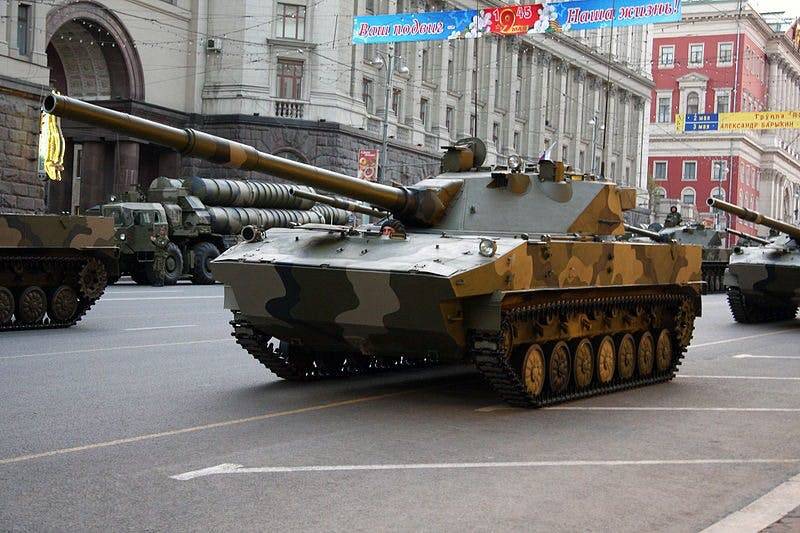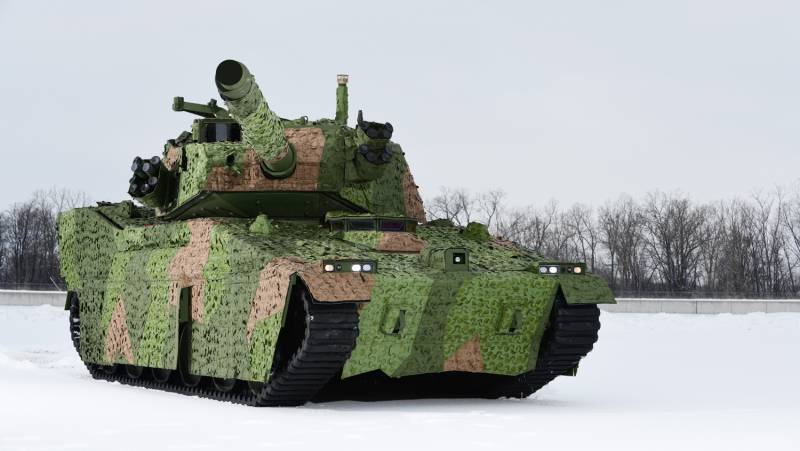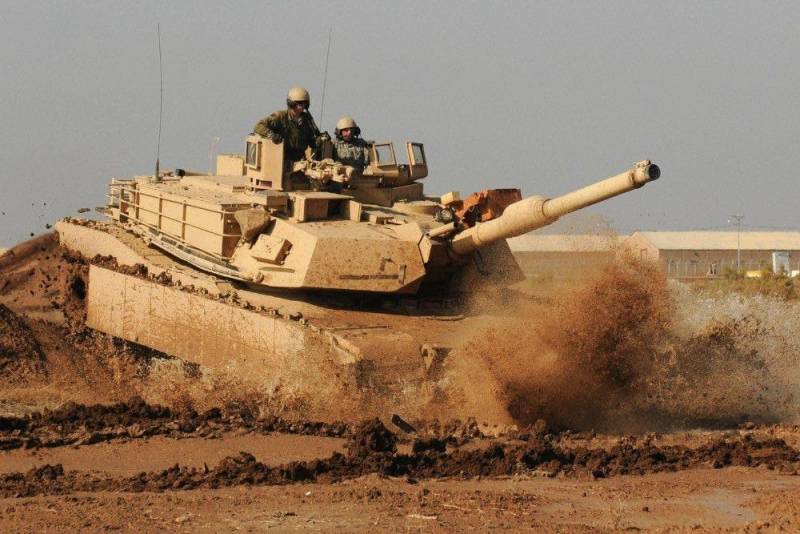Warrior Maven: US Army plans to build a prototype "light tank"
On September 7, the American online publication Warrior Maven published a new article by Chris Osbourne entitled "Army Plans Prototype New" Light Tank "Mobile Protected Firepower-2020" - "The Army plans to build a prototype of the new" light tank"Mobile Protected Firepower." The same day the article was reprinted by The National Interest, and this time it received a new, louder title: “1 Way the Army Plans to Make Sure It Can Beat Russia In a Land War” (“The only way for the army to defeat Russia in the land war ”). The content of both publications is identical.
In the subtitle to the original article, the author indicated that the new American project pursues a simple goal. The Mobile Protected Firepower / MPF ready machine should surpass similar samples of the Russian army.
K. Osborne recalls that in the coming years, the US Army intends to develop and build a promising military armored vehicle that can change the look of the land war. It will have to fight with its Russian counterparts, as well as support infantry on the battlefield, sharply increasing its combat potential.
The US military leadership has previously explained the background to the emergence of the MPF project. Exact long-range fire, air strikes, land combat vehicles collision and widespread UAVs lead to a rapid change in the situation on the battlefield. In this regard, the American army needs improved land vehicles to fight a developed enemy.
Earlier this year, Deputy Chief of Staff G9 of the Combat Training Command and the Development of the Doctrine of the US Army Ricky Smith revealed some details of a promising project to the Warrior Maven publication. According to him, the MPF machine will be useful, including because of the possibility of working off-road. At the same time, high mobility helps to effectively use protection and firepower, since it is possible to detect and attack the enemy before retaliation, which can deprive your armored vehicle of mobility.
R. Smith did not specify the exact parameters of the future MPF machine at that time, but noted that at the present time, specialists are looking for the optimal ratio of the three main parameters that are in the name of the program. It is necessary to find the best balance between mobility, level of protection and the power of weapons. At the same time, as K. Osborne writes, the top leadership of the US Army believes that the MPF will surpass Russian equipment of its class in survivability and firepower.
The Russian self-propelled anti-tank gun 2C25 "Sprut-SD" is considered as an analogue and contender for Mobile Protected Firepower. This machine has a combat weight of about 20 t and is armed with an 125-mm smooth-bore gun launcher. "Sprut-SD" is intended to combat enemy tanks and fire support of amphibious or infantry units. Russian self-propelled gun is in service with the 2005 year.
K. Osborne recalls the statements of the American armored vehicle makers. They argue that the MPF machine of their development is likely to be more severe than the Russian Sprut-SD, which will provide an advantage in the level of protection.
In hypothetical combat operations against a developed enemy that has modern equipment with effective means of detection, high-precision armament and air support, the army needs appropriate mobile ground-based fire support equipment. Now this role is given to the main tanks M1 Abrams, which have powerful reservations and carry 120-mm gun. However, the mass and mobility of such equipment may not meet the conditions and limitations of certain situations.
Commenting on the MPF project, R. Smith recalled the formation of new divisions such as Infantry Brigade Combat Teams (IBCT), which will work in a variety of conditions. They need armored vehicles with high mobility, as well as powerful protection and weapons. Knowing the capabilities of the likely adversary and considering the main risks, the army wants to equip the IBCT with armored vehicles like Mobile Protected Firepower. The latter should actually close the existing niche in which the existing samples of military equipment cannot work.
K. Osborne notes that the future MPF is often called a light tank, but this definition does not quite correspond to reality. According to official information, the aim of the project is to create a promising platform with weapons for direct fire and infantry support. All this does not fully meet the definition of a light tank.
The project places special emphasis on high strategic mobility and the possibility of transporting vehicles by military transport aircraft. So, at once two proposed versions of the MPF project from different companies provide for the possibility of loading such equipment into the C-17 aircraft. The author points out that strategic mobility is of particular importance when working in areas such as Europe. The fact is that in this region, Russian troops, including those armed with “Sprutami-SD”, find themselves at a minimum distance from parts of the United States and NATO.

The author suggests that the IBCT units on the battlefield may face a number of threats, such as armored columns, precision weapons, artillery, etc. In order to combat such threats, advantages in the detection and destruction range are necessary, which will make it possible to strike earlier. At the same time, one can observe how the requirements for armored vehicles for the ground forces have changed by now. According to current views, the battle armored vehicles of the future must have the firepower of tanks and the mobility of light samples in order to move with the infantry.
Currently, the US defense industry is studying the technical requirements for Mobile Protected Firepower, as well as looking for the most appropriate options for the appearance of such equipment. In 2019, the Pentagon plans to review the submitted projects and select the two most successful ones. Their developers will receive a contract for further development work. During the 14 months after signing the contracts, contractors will have to submit prototypes of the equipment.
K. Osborne writes that the customer can adjust his requirements as the project develops, but the main features of the future armored vehicle have already been identified. According to the Globalsecurity.org portal, MPF projects should include stabilized artillery weapons and optical-electronic systems capable of operating at any time of the day and in any weather.
Competition developers include BAE Systems and General Dynamics Land Systems. They are competitors and plan to compete with each other, which is why they are not in a hurry to disclose the details of their projects.
In parallel with the process of creating a new technology, the army intends to focus on another issue. She plans to implement a “bidirectional acquisition strategy.” The command assumes to preserve the existing models of weapons and equipment, to which completely new ones will be gradually added. As a result, the structure of the armed forces and their materiel must be such as not to impede the integration of new products.
A search was made for technologies that could provide the new MPF with the required capabilities and provide advantages over the enemy. First of all, the possibility of using lightweight combined booking, active protection complexes and modern optical-electronic equipment with high resolution is being considered. It is also proposed to use automated computing systems capable of taking on part of the crew’s work.
The possibility of connecting several functions in one device is considered. For example, one device will be able to perform the functions of a video and infrared camera, electromagnetic sensor, etc. All data from different elements of the device will flow into the computer and be used, including when generating data for firing.
Arguing on this topic, R. Smith pointed out that the combined devices will be able to positively affect the characteristics of technology. Thus, in desert conditions, problems may arise with the use of infrared equipment, in which case data should be collected using other means that can continue to work. In different conditions, the armored vehicle may need all the available types of sensors and means of observation.
According to Chris Osborne, the Center for Research and Development of Communication Technologies (CERDEC) is already engaged in creating combined surveillance tools that combine different devices. At the same time, such tools are created not just for MPF armored vehicles, but as part of the more extensive and lengthy Next-Generation Combat Vehicle (NGCV) program. According to current plans, the result of the NGCV program will be the emergence of a wide range of different combat and auxiliary vehicles on a common platform. Such equipment will have to get to the troops no earlier than the end of the twenties.
Another of the main issues of the MPF perspective program is the creation of tools with suitable characteristics. Armament for such a machine should have a sufficiently high firepower, but at the same time be different in acceptable size and weight. The gun should not impair mobility on the ground and the strategic mobility of its carrier.
According to the document Combat Vehicle Modernization Strategy, which determines the further ways of upgrading armored combat vehicles of the US Army, it is necessary to ensure the integration of powerful 120-mm tank guns on relatively light platforms. In particular, an experienced XM360 gun, previously created for the future armored Future Combat Systems, can be used as such. Currently, this weapon is considered in the context of the NGCV program or the modernization of existing tanks. However, it may be of interest to the developers of the new project Mobile Protected Firepower.
In the XM360 project, a number of new technologies and engineering solutions were used, due to which a reduction in the recoil momentum from a relatively powerful 120-mm unitary shot was provided. Because of this, it could be used on light platforms with limited characteristics.
Previously announced some features of the design of promising weapons. The project involved the use of a heat shield of the barrel and the muzzle brake. The barrel group was assembled from several units, the installation for it had a modular design and included hydropneumatic anti-recoil devices. Used wedge gate with an external electric drive.
***
The goal of the current Mobile Protected Firepower program is to create a promising armored vehicle that combines effective defenses, weapons and high mobility. To date, the Pentagon has submitted the terms of reference for the project, and the companies participating in the program have begun design work.
Three companies expressed their desire to create a promising model of armored vehicles. The company BAE Systems presented to the competition seriously modified light tank M8 AGS, originally developed for one of the previous American programs. General Dynamics Land Systems performs a project called Griffin. Science Applications International Corporation last year unveiled its version of the MPF, based on the older project of the Next Generation Armored Fighting Vehicle light tank. Currently, companies are busy testing and refining promising samples.
Next year, the Pentagon will have to choose the two most successful models of technology, which will be further developed. In the mid-twenties, the US Army plans to equip the first division with armored vehicles of the type MPF. In the future, on such equipment will transfer new parts and connections. According to current plans, each machine of the new model should cost no more than 6-6,5 million dollars. It is supposed to purchase about 500 units of such equipment.
The competing companies have already submitted their versions of Mobile Protected Firepower, but the search for ideas and technologies for the implementation of the technical task continues. This technique should have special characteristics and capabilities, which leads to the need to use new components, including those that have not yet been created. Whether it will be possible to solve the tasks, and what the actual MPF will be for the troops, will be known later.
The “Army Plans Prototype New" Light Tank Mobile Protected Firepower-2020 article:
https://defensemaven.io/warriormaven/land/army-plans-prototype-new-light-tank-mobile-protected-firepower-2020-woj3dCkdzUWxWr2Vcu0WnA/


Information